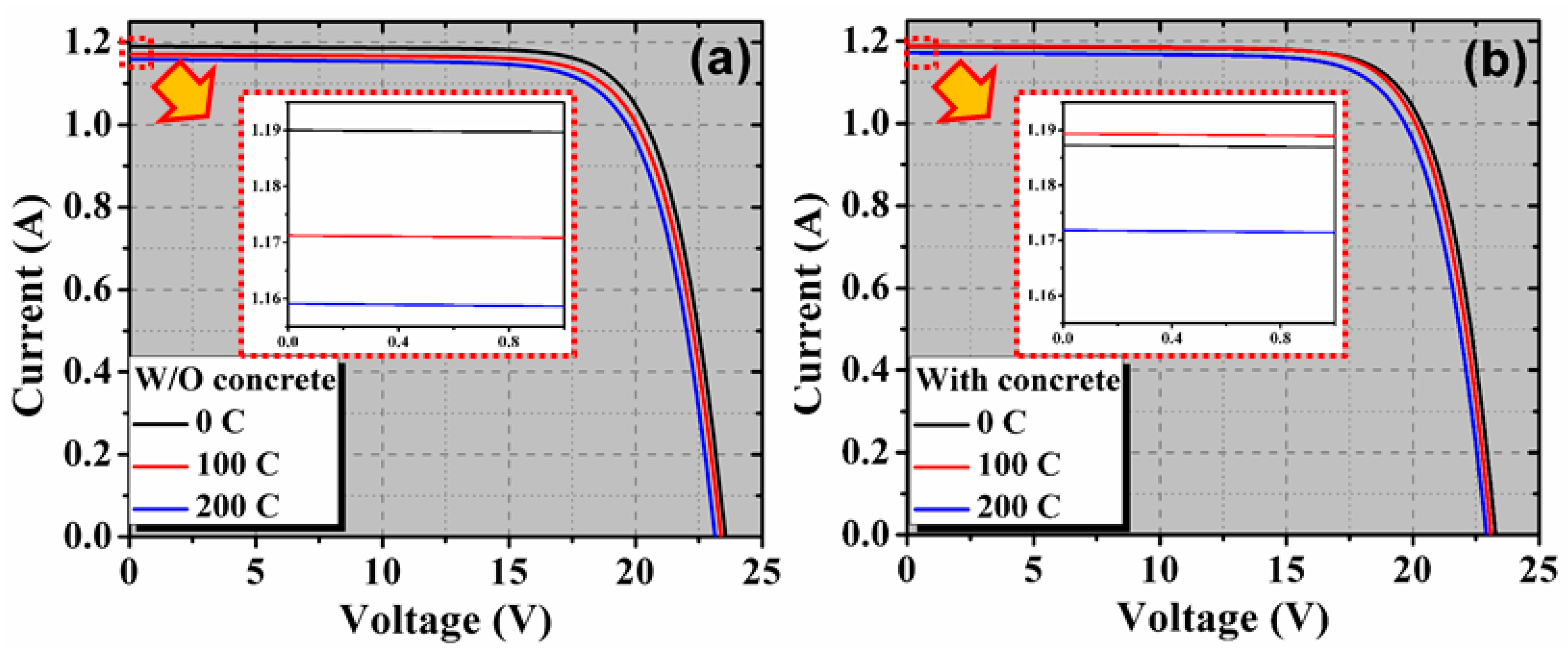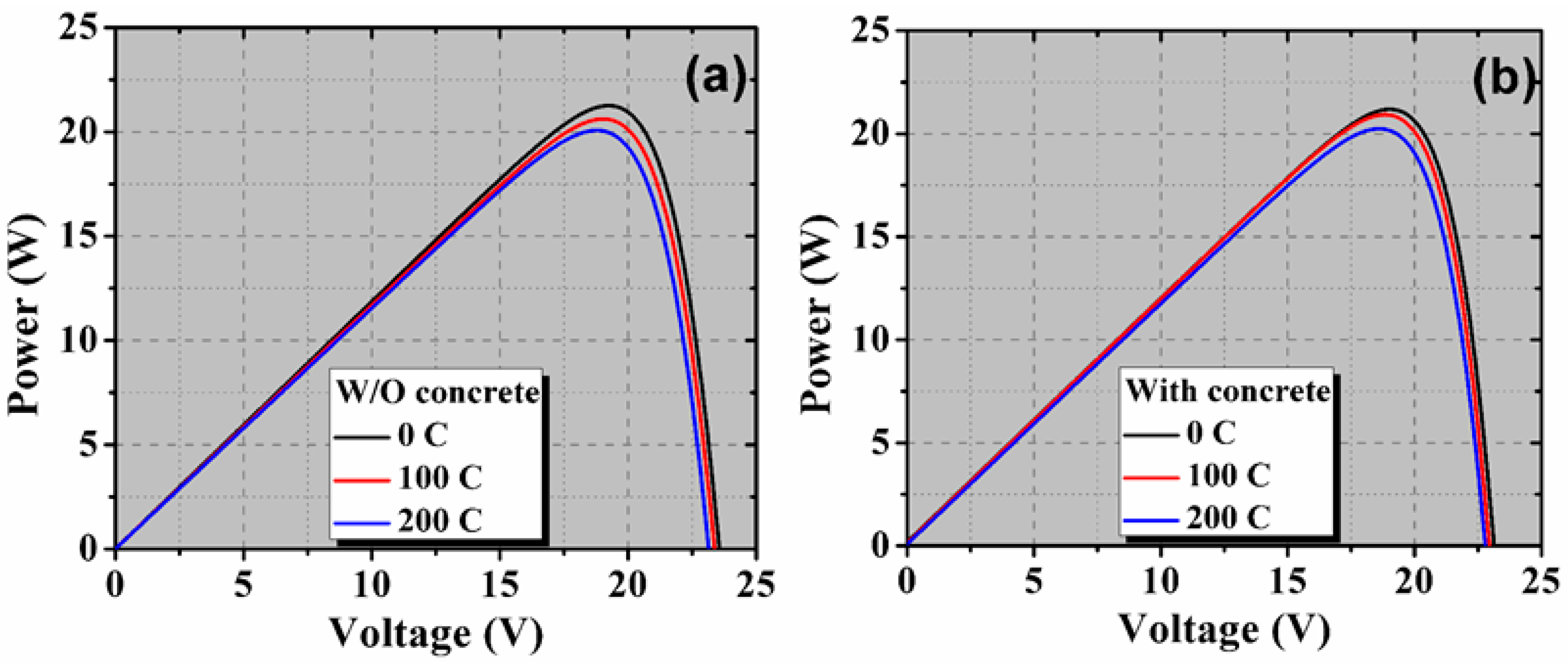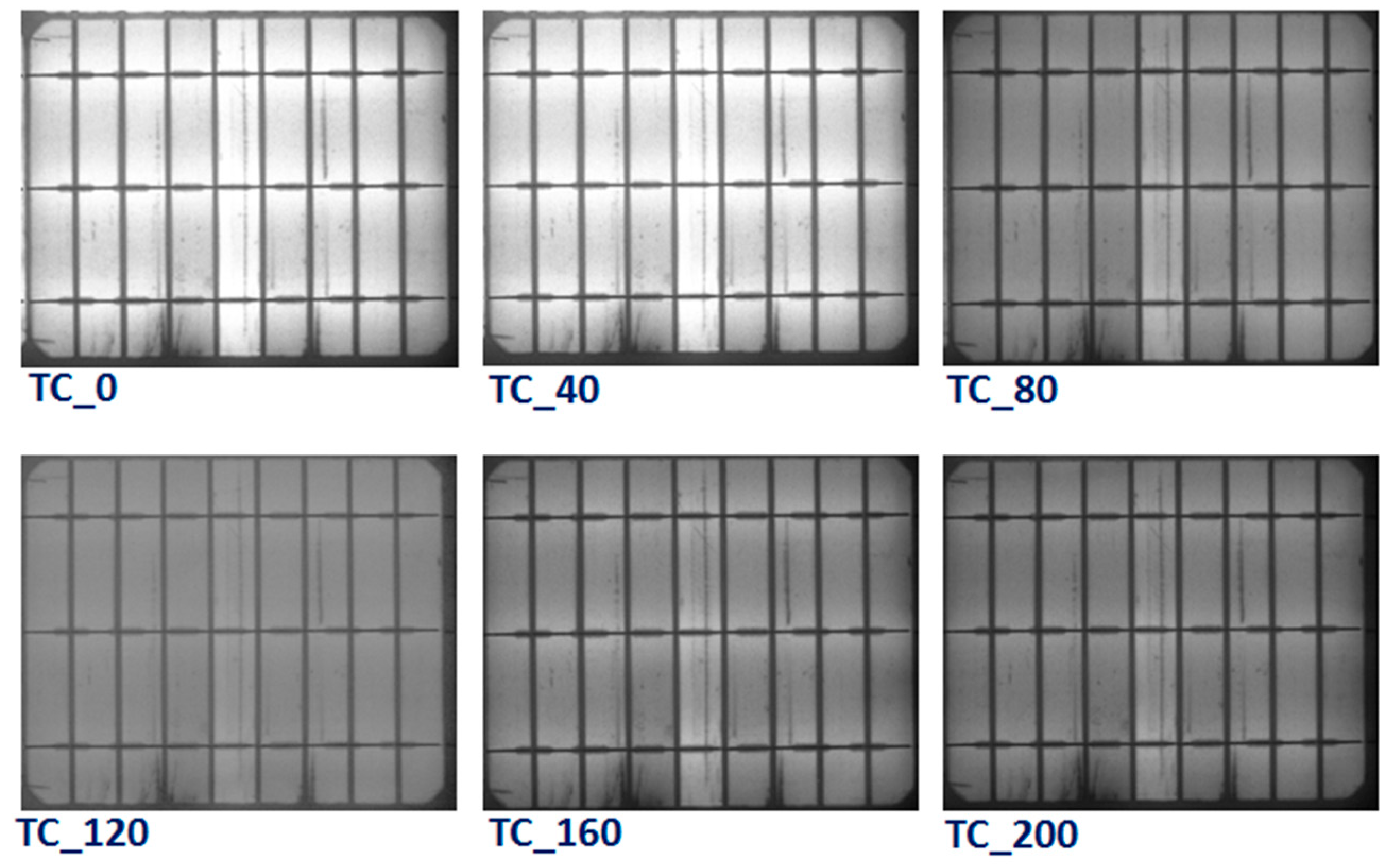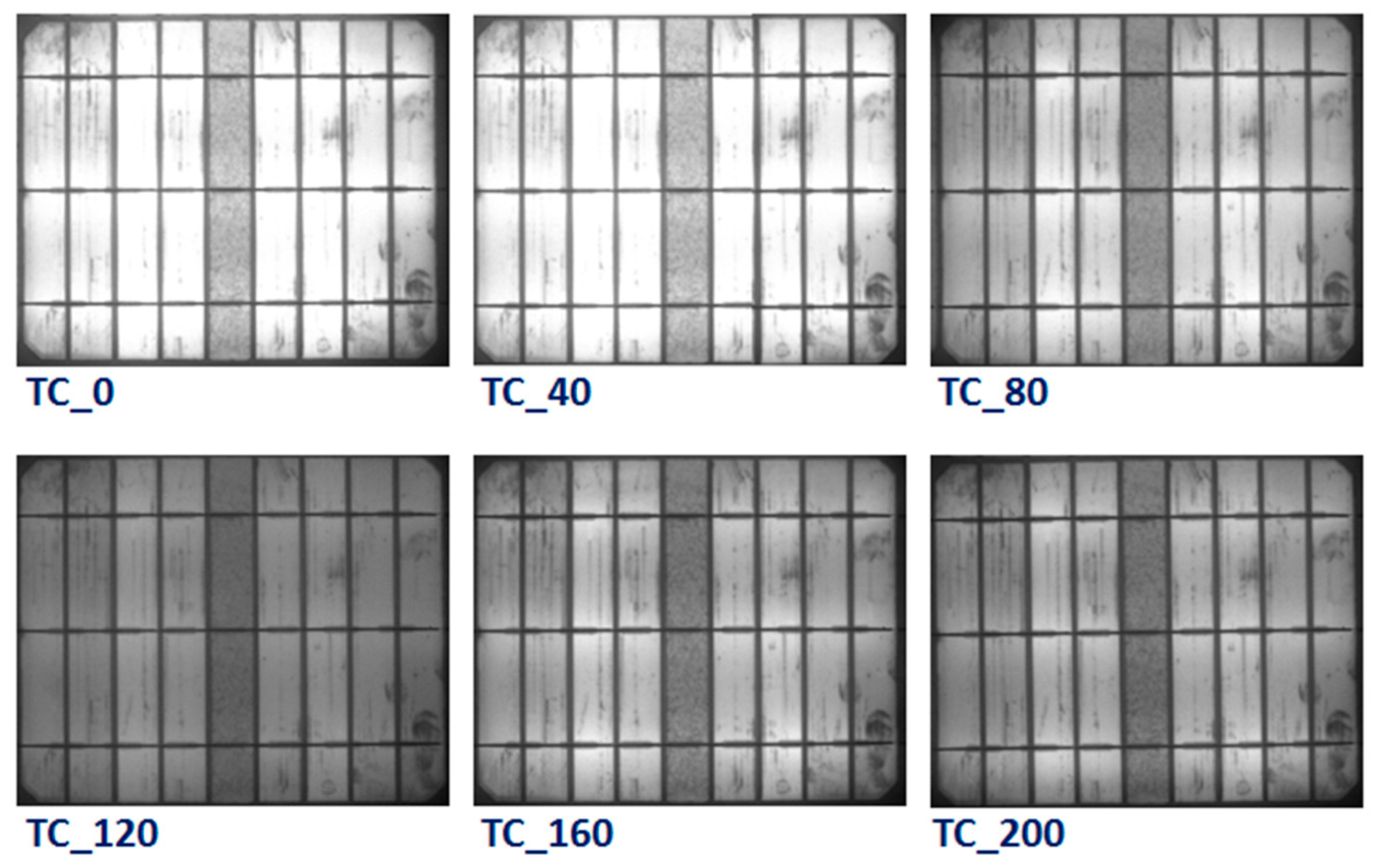Reliability Study of c-Si PV Module Mounted on a Concrete Slab by Thermal Cycling Using Electroluminescence Scanning: Application in Future Solar Roadways
Abstract
:1. Introduction
2. Theoretical
3. Experimental Details
4. Results and Discussion
4.1. Performance Parameters Analysis
4.2. PV Cell Parameters Analysis
5. Conclusions
Author Contributions
Funding
Acknowledgments
Conflicts of Interest
References
- Nyarko, F.K.A.; Takyi, G.; Amalu, E.H.; Adaramola, M.S. Generating temperature cycle profile from in-situ climatic condition for accurate prediction of thermo-mechanical degradation of c-Si photovoltaic module. Eng. Sci. Technol. Int. J. 2019, 22, 502–514. [Google Scholar] [CrossRef]
- Herrmann, W.; Bogdanski, N.; Reil, F.; Köhl, M.; Weiss, K.-A.; Assmus, M.; Heck, M. PV Module degradation caused by thermomechanical stress: Real impacts of outdoor weathering versus accelerated testing in the laboratory, In Reliability of Photovoltaic Cells, Modules, Components, and Systems III. SPIE 2010, 7773, 77730I. [Google Scholar]
- Osterwald, C.R.; McMahon, T.J. History of Accelerated and Qualification Testing of Terrestrial Photovoltaic Modules: A Literature Review. Prog. Photovolt: Res. Appl. 2009, 17, 11–33. [Google Scholar] [CrossRef]
- Jordan, D.C.; Wohlgemuth, J.H.; Kurtz, S.R. Technology and climate trends in PV module degradation. In Proceedings of the 27th European Photovoltaic Solar Energy Conference and Exhibition, Frankfurt, Germany, 24–28 September 2012. [Google Scholar]
- Ogbomo, O.O.; Amalu, E.H.; Ekere, N.N.; Olagbegi, P.O. Effect of coefficient of thermal expansion (CTE) mismatch of solder joint materials in photovoltaic (PV) modules operating in elevated temperature climate on the joint’s damage. Procedia Manuf. 2017, 17, 1145–1152. [Google Scholar] [CrossRef] [Green Version]
- Wang, E.; Yen, K.-H.; Wang, C.; Ji, L.; Zgonena, T. Accelerated Aging Tests on PV Grounding Connections. Energy Procedia 2011, 12, 578–585. [Google Scholar] [CrossRef] [Green Version]
- Braisaz, B.; Duchayne, C.; Van Iseghem, M.; Radouane, K. PV aging model applied to several meteorological conditions. In Proceedings of the 29th European Photovoltaic Solar Energy Conference (EUPVSEC), Amsterdam, The Netherlands, 22–26 September 2014; pp. 22–26. [Google Scholar]
- International Electrotechnical Commission. Crystalline Silicon Terrestrial Photovoltaic (PV) Modules-Design Qualification and Type Approval, IEC 61215, 2nd ed.; IEC Central Office: Geneva, Switzerland, 2005. [Google Scholar]
- Papadimitriou, C.N.; Psomopoulos, C.S.; Kehagia, F. A review on the latest trend of Solar Pavements in Urban Environment. Energy Procedia 2019, 157, 945–952. [Google Scholar] [CrossRef]
- Global Status Report, Towards a Zero-Emission, Efficient and Resilient Buildings and Construction Sector. 2018. Available online: https://globalabc.org/uploads/media/default/0001/01/f64f6de67d55037cd9984cc29308f3609829797a.pdf (accessed on 19 June 2018).
- Kawai, S.; Tanahashi, T.; Fukumoto, Y.; Tamai, F.; Masuda, A.; Kondo, M. Causes of degradation identified by the extended thermal cycling test on commercially available crystalline silicon photovoltaic modules. IEEE J. Photovolt. 2017, 7, 1511–1518. [Google Scholar] [CrossRef]
- Tsanakas, J.A.; Karoglou, M.; Delegou, E.T.; Botsaris, P.N.; Bakolas, A.; Moropoulou, A. Assessment of the performance and defect investigation of PV modules after accelerated aging tests. Renew. Energy Power Qual. J. 2013, 1, 866–872. [Google Scholar] [CrossRef] [Green Version]
- Mathiak, G.; Althaus, J.; Menzler, S.; Lichtschläger, L.; Herrmann, W. PV module corrosion from ammonia and salt mist-experimental study with full-size modules. Proceedings of 27th European Photovoltaic Solar Energy Conference (EUPVSEC), Frankfurt, Germany, 24–28 September 2012; pp. 3536–3540. [Google Scholar]
- Khan, F.; Baek, S.H.; Kim, J.H. Intensity dependency of photovoltaic cell parameters under high illumination conditions: An analysis. Appl. Energy 2014, 133, 356–362. [Google Scholar] [CrossRef]
- Khan, F.; Baek, S.H.; Park, Y.; Kim, J.H. Extraction of diode parameters of silicon solar cells under high illumination conditions. Energy Convers. Manag. 2013, 76, 421–429. [Google Scholar] [CrossRef]
- Phang, J.C.H.; Chan, D.S.H.; Phillips, J.R. Accurate analytical method for the extraction of solar cell model parameters. Electron. Lett. 1984, 20, 406–408. [Google Scholar] [CrossRef]
- Khan, F.; Baek, S.H.; Kim, J.H. Wide range temperature dependence of analytical photovoltaic parameters for silicon solar cells under high illumination conditions. Appl. Energy 2016, 183, 715–724. [Google Scholar] [CrossRef]
- Khan, F.; Baek, S.H.; Kim, J.H. Performance degradation analysis of c-Si PV modules mounted on a concrete slab under hot-humid conditions using electroluminescence scanning technique for potential utilization in future solar roadways. Materials 2019, 12, 4047. [Google Scholar] [CrossRef] [Green Version]
- Breitenstein, O.; Rakotoniaina, J.P.; Al Rifai, M.H.; Werner, M. Shunt type in crystalline silicon solar cells. Prog. Photovolt.: Res Appl. 2004, 12, 529–538. [Google Scholar] [CrossRef] [Green Version]
- Lang, D.V. Deep-level transient spectroscopy: A new method to characterize traps in semiconductors. J. Appl. Phys. 1974, 45, 3023–3032. [Google Scholar] [CrossRef]
- Khan, F.; Singh, S.N.; Husain, M. Effect of illumination intensity on cell parameters of a silicon solar cell. Sol. Ener. Mater. Sol. Cell. 2010, 94, 1473–1476. [Google Scholar] [CrossRef]
- Rummel, S.R.; McMahon, T.J. Effect of cell shunt resistance on module performance at reduced light levels. AIP Conf. Proc. 1996, 353, 581. [Google Scholar]
- Chakravarty, B.C.; Arora, N.K.; Singh, S.N.; Das, B.K. Solar Cell Performance with an Inhomogeneous Grain Size Distribution. IEEE Trans. Electron. Dev. 1986, 33, 158160. [Google Scholar] [CrossRef]
- Meyer, E.L.; Dyk, E.E. Assessing the reliability and degradation of photovoltaic module performance parameters. IEEE Trans. Reliab. 2004, 53, 83–92. [Google Scholar] [CrossRef]









© 2020 by the authors. Licensee MDPI, Basel, Switzerland. This article is an open access article distributed under the terms and conditions of the Creative Commons Attribution (CC BY) license (http://creativecommons.org/licenses/by/4.0/).
Share and Cite
Khan, F.; Rezgui, B.D.; Kim, J.H. Reliability Study of c-Si PV Module Mounted on a Concrete Slab by Thermal Cycling Using Electroluminescence Scanning: Application in Future Solar Roadways. Materials 2020, 13, 470. https://doi.org/10.3390/ma13020470
Khan F, Rezgui BD, Kim JH. Reliability Study of c-Si PV Module Mounted on a Concrete Slab by Thermal Cycling Using Electroluminescence Scanning: Application in Future Solar Roadways. Materials. 2020; 13(2):470. https://doi.org/10.3390/ma13020470
Chicago/Turabian StyleKhan, Firoz, Béchir Dridi Rezgui, and Jae Hyun Kim. 2020. "Reliability Study of c-Si PV Module Mounted on a Concrete Slab by Thermal Cycling Using Electroluminescence Scanning: Application in Future Solar Roadways" Materials 13, no. 2: 470. https://doi.org/10.3390/ma13020470



